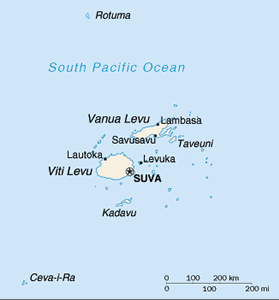The Geography of Fiji
The Geography of Fiji
Fijian Geography
Location: Oceania, island group in the South Pacific Ocean, about two-thirds of the way from Hawaii to New Zealand
Geographic coordinates: 18 00 S, 175 00 E
Map references: Oceania
Area: total: 18,270 sq km land: 18,270 sq km water: 0 sq km
Area - comparative: slightly smaller than New Jersey
Land boundaries: 0 km
Coastline: 1,129 km
Maritime claims: measured from claimed archipelagic straight baselines territorial sea: 12 nm exclusive economic zone: 200 nm continental shelf: 200 m depth or to the depth of exploitation; rectilinear shelf claim added
Climate: tropical marine; only slight seasonal temperature variation
Terrain: mostly mountains of volcanic origin
Elevation extremes: lowest point: Pacific Ocean 0 m highest point: Tomanivi 1,324 m
Natural resources: timber, fish, gold, copper, offshore oil potential, hydropower
Land use: arable land: 10.95% permanent crops: 4.65% other: 84.4% (2005)
Irrigated land: 30 sq km (2003)
Natural hazards: cyclonic storms can occur from November to January
Environment - current issues: deforestation; soil erosion
Environment - international agreements: party to: Biodiversity, Climate Change, Climate Change-Kyoto Protocol, Desertification, Endangered Species, Law of the Sea, Marine Life Conservation, Ozone Layer Protection, Tropical Timber 83, Tropical Timber 94, Wetlands signed, but not ratified: none of the selected agreements
Geography - note: includes 332 islands; approximately 110 are inhabited


